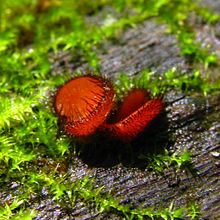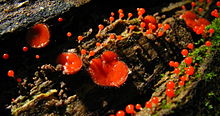- Scutellinia scutellata
-
Scutellinia scutellata 
Scientific classification Kingdom: Fungi Division: Ascomycota Class: Pezizomycetes Order: Pezizales Family: Pyronemataceae Genus: Scutellinia Species: S. scutellata Binomial name Scutellinia scutellata
(L.) Lamb.Synonyms Patella scutellata (L.) Morgan
Scutellinia scutellata, commonly known as the eyelash cup, the Molly eye-winker, the scarlet elf cap, the eyelash fungus or the eyelash pixie cup, is a small saprophytic fungus of the genus Scutellinia. It is the type species of Scutellinia, as well as being the most common and widespread. The fruiting bodies are small red cups with distinct long, dark hairs or "eyelashes". These eyelashes are the most distinctive feature and are easily visible with a magnifying glass. The species is common in North America and Europe, and has been recorded on every continent. S. scutellata is found on rotting wood and in other damp habitats, typically growing in small groups, sometimes forming clusters. It is sometimes described as inedible, but its small size means it is not suitable for culinary use. Despite this, it is popular among mushroom hunters due to its unusual "eyelash" hairs, making it memorable and easy to identify.
Contents
Taxonomy
S. scutellata was first described in 1753 by Carl Linnaeus in his book Species Plantarum as Peziza scutellata, and it was given its current name by Jean Baptiste Émil Lambotte in Memoires societe royale des sciences de Liege in 1887. It was also named Patella scutellata in 1902.[1] The specific name scutellata is from the Latin for "like a small shield".[2] Common names include the eyelash fungus,[3] the eyelash cup,[2] the scarlet elf cap,[4] the Molly eye-winker[5] and the eyelash pixie cup.[6]
The Scutellinia genus is currently placed in the Pyronemataceae family. However, genera of the Pyronemataceae lack unifying macroscopic or microscopic characteristics; this lack of uniting characters has led various authors to propose a variety of classification schemes.[7][8][9] A 1996 study of British specimens of Scutellinia revealed that the species S. crinita, originally described as Peziza crinita in 1789 by French botanist Jean Baptiste François Pierre Bulliard, was synonymous with S. scutellata.[10]
Description
The fruiting body of S. scutellata is a shallow disc shape, typically between 0.2 to 1 cm (0.1 to 0.4 in) in diameter.[3] The youngest specimens are almost entirely spherical; the cups open up and expand to a disc during maturity.[6] The inner surface of the cup (the fertile spore-bearing surface, known as the hymenium) is bright orange-red, while the outer surface (the sterile surface) is pale brown.[11] The flesh is red and thin.[12] The outer surface is covered in dark coloured, stiff hairs, measuring up to 1 centimetre (0.4 in) in length. At the base, these hairs are up to 40 µm (0.0016 in) thick, and they taper towards the pointed apices. The hairs form distinctive "eyelashes" on the margin of the cup that are visible to the naked eye.[3] or easily visible through a magnifying glass.[13] S. scutellata is sessile—it does not have a stalk.[6]
Microscopic features
S. scutellata has asci of approximately 300 µm by 25 µm in size, and releases elliptical spores measuring 18 to 19 µm by 10 to 12 µm. The translucent (hyaline)[13] ascospores have a rough exterior, (with very small warts)[6] and contain small droplets of oil.[3] They are white when present in large numbers, like a spore print.[2] The paraphyses are cylindrical in shape and feature septa partitioning the hypha into distinct cells.[14] Electron microscopy of the top of the ascus has revealed a roughly delimited operculum (a flap-like covering of the ascus) and ascostome (a pore in the apex of the ascus), and a subapical ring.[15]
Edibility
While some list S. scutellata as inedible,[3][16] others list it as having an unknown edibility.[17] David Arora considers it too small to be of any culinary interest,[6] and it lacks a distinctive smell or taste.[14]
Distribution and habitat
S. scutellata is common in both Europe, where it can be found from late spring to late autumn,[3] and North America, where it fruits in winter and spring.[6] It has also been collected in Cameroon,[18] Colombia,[19] East Asia,[1][20] India,[21] Iceland,[22] Israel,[23] New Guinea and the Solomon Islands,[24] Russia,[25] and Turkey.[26]
A saprobic species, it grows generally in subalpine regions,[2] fruiting on rotten wood and damp soil,[3] and can also sometimes be found on ashes, wet leaves or bracket fungi.[6] In Alaska it has been found growing on humus in the tundra.[17] A six year study of the succession of fungal flora appearing on freshly cut stumps of Poplar trees (Populus canadensis) showed that S. scutellata appeared roughly in the middle of the fungal succession (about 2–4 years after the tree had been cut), along with the species Ascocoryne sarcoides, Scutellinia cervorum, and Lasiosphaeria spermoides.[27] When growing on wood, it is often obscured by surrounding moss.[14] Though sometimes found alone, they typically fruit in groups,[2] sometimes forming dense clusters on rotting wood or other plant detritus.[13] Due to its small size, it is often overlooked,[6] but mycologist Vera Evenson has observed that "the discovery of the Eyelash Cup is always a great pleasure", due to "the beauty of the eyelashes".[2] Vera McKnight describes it as "a most attractive little fungus", and claims it is easy to notice due to its bright colouration.[13]
Carotenoids
The carotenoids are pigmented molecules found naturally in plants, and some types of fungi, including S. scutellata. A 1965 study reported the carotenoid composition of this fungus, found to contain a high proportion of monocyclic carotenes—carotenes with only one cyclohexene ring, such as beta-carotene. Also present were minor amounts of xanthophyll, a molecule structurally related to the carotenes.[28]
Similar species
Of more than a dozen species of Scutellinia, S. scutellata is the most common and widespread, though a microscope is required to differentiate between some of them.[13] It is also the type species of the genus.[1] It is differentiated from most other Scutellinia by its larger size, and its distinctive "eyelashes".[11] Although David Arora describes S. scutellata as "easily recognizable",[6] it can be mistaken for S. umbrarum (which has a larger fruiting body and larger spores, as well as having shorter, less obvious hairs) S. erinaceus (which is slightly smaller, and orange to yellow in colour, with smooth spores), Cheilymenia crucipila (which is much smaller, with short, pale hairs and spores lacking oil droplets) and Melastiza chateri, which is bright orange with small brown hairs.[6] The "Pennsylvania eyelash cup" (S. pennsylvanica) is a smaller North American version that has smaller hairs and spores that are more coarsely warted than S. scutellata.[12] S. barlae is very similar as well, and can only be reliably distinguished by its roughly spherical ascospores that are typically 17–23 µm in diameter.[18] Species from the Lamprospora genus are smaller and hairless.[6] Similar fungi that favour dung over rotting wood include Cheilymenia coprinaria, C. theleboides, and Coprobia granulata while species such as Anthracobia macrocystis, Anthracobia melaloma, Trichophaea abundans, Pyronema omphalodes, Pulvinula carbonaria and Pulvinula archeri are cup fungi that favour burned-over ground.[6]
References
- ^ a b c Bi Z, Zheng G, Li T (1993). The Macrofungus Flora of China's Guangdong Province. Chinese University Press. pp. 41–42. ISBN 9789622015562.
- ^ a b c d e f Evenson VS (1997). Mushrooms of Colorado and the Southern Rocky Mountains. Englewood, Colo: Westcliffe Publishers. p. 189. ISBN 1-56579-192-4.
- ^ a b c d e f g Phillips R (1981). Mushrooms and Other Fungi of Great Britain and Europe. London: Pan Books. p. 273. ISBN 0330264419.
- ^ Zwinger AH (2002). Beyond the aspen grove. Boulder, Colo.: Johnson Books. p. 358. ISBN 9781555662790.
- ^ Emberger G. "Scutellinia scutellata". Messiah College. http://www.messiah.edu/Oakes/fungi_on_wood/cup%20and%20saucer/species%20pages/Scutellinia%20scutellata.htm. Retrieved 1 July 2009.
- ^ a b c d e f g h i j k l Arora D (1986). Mushrooms Demystified : a Comprehensive Guide to the Fleshy Fungi. Berkeley, California: Ten Speed Press. pp. 838–839. ISBN 0-89815-170-8.
- ^ Kimbrough JW (1989). "Arguments towards restricting the limits of the Pyronemataceae (Ascomycetes, Pezizales)". Memoirs of the New York Botanic Garden 49: 326–35.
- ^ Eckblad F-E (1968). "The genera of operculate Discomycetes. A re-evaluation of their taxonomy, phylogeny and nomenclature". Norwegian Journal of Botany 15: 1–191.
- ^ Korf RP (1972). "Synoptic key to the genera of Pezizales". Mycologia 64 (5): 937–94. doi:10.2307/3758070. http://jstor.org/stable/3758070.
- ^ Yao YJ, Spooner BM (1996). "Notes on British species of Scutellinia". Mycological Research 100 (7): 859–65. doi:10.1016/S0953-7562(96)80035-9.
- ^ a b Kuo, Michael. "Scutellinia scutellata". MushroomExpert.com. http://www.mushroomexpert.com/scutellinia_scutellata.html. Retrieved 1 July 2009.
- ^ a b Schalkwijk-Barendsen HME (1991). Mushrooms of Western Canada. Edmonton: Lone Pine Publishing. p. 388. ISBN 0-919433-47-2.
- ^ a b c d e McKnight VB (1987). A Field Guide to Mushrooms, North America. Boston: Houghton Mifflin. p. 63. ISBN 0-395-91090-0.
- ^ a b c Jordan M (1995). The Encyclopedia of Fungi of Britain and Europe. David & Charles. p. 51. ISBN 0-7153-0129-2.
- ^ VanBrummelen J (1993). "Ultrastructure of the ascus and the ascospore wall in Scutellinia (Pezizales, Ascomycotina)". Persoonia 15 (2): 129–48.
- ^ Kibby G (1994). An Illustrated Guide to Mushrooms and Other Fungi of North America. Lubrecht & Cramer Ltd. p. 177. ISBN 0-681-45384-2.
- ^ a b Orr DB, Orr RT (1979). Mushrooms of Western North America. Berkeley: University of California Press. p. 28. ISBN 0-520-03656-5.
- ^ a b Douanla-Meli C, Langer E (2005). "Notes on Discomycetes (Helotiales, Pezizales): New species and new records from Cameroon". Mycotaxon 92: 223–37.
- ^ Tobon LE (1991). "Ascomycetes of Colombia Discomycetes of the department of Antioquia" (in Spanish). Caldasia 16 (78): 327–336.
- ^ Chen Z-C (1975). "Notes on new Formosan forest fungi part 2. Some lignicolous fungi" (in Taiwanese). Taiwania 20 (2): 201–212.
- ^ Batra LR, Batra SWT (1963). "Indian Discomycetes". University of Kanses Scientific Bulletin 44 (1/14): 109–256.
- ^ Hallgrimsonn (1989). "The genus Scutellinia Cooke Lamb. in Iceland" (in Icelandic). Natturufraedingurinn 59 (3): 133–40.
- ^ Nemlich H, Avizoharhershenzon Z (1976). "Pezizales of Israel .4. Humariaceae (B)". Israel Journal of Botany 25 (1–2): 41–52.
- ^ Otani Y (1971). "Mycological reports from New Guinea and the Solomon Islands part 3. Enumeration of the Sarcoscyphaceae and Scutellinia humariaceae". Bulletin of the National Science Museum (Tokyo) 14 (3): 401–422.
- ^ Stepanova OA (1973). "Fungi on felling debris in spruce forests of the Leningrad region. Part 1" (in Russian). Mikologiya i Fitopatologiya 7 (5): 386–91.
- ^ Dogan HH (2006). "Macrofungi and their distribution in Karaman province, Turkey". Turkish Journal of Botany 30 (3): 193–207.
- ^ Runge A (1982). "Succession of fungi on Poplar Populus canadensis stumps" (in German). Zeitschrift für Mykologie 48 (1): 133–40.
- ^ Jensen SL (1965). "On fungal carotenoids and the natural distribution of spirilloxanthin". Phytochemistry 4 (6): 925–31. doi:10.1016/S0031-9422(00)86270-6.
External links
Categories:- Pezizales
- Fungi described in 1753
- Fungi of Europe
- Fungi of Asia
- Fungi of North America
- Fungi of South America
- Fungi of Africa
- Fungi of Oceania
- Inedible fungi
Wikimedia Foundation. 2010.


